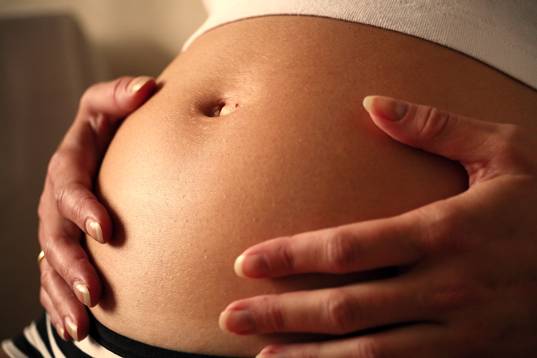? ? ? ? ? ?การคลอด เกิดขึ้นเองตามธรรมชาติ เมื่อมนุษย์มีการศึกษาถึงการคลอด และกำหนดลักษณะของการคลอดปกติขึ้น การวางแผนการคลอดให้ดำเนินไปตามปกติจึงตามมา ซึ่งแพทย์ผู้ดูแลการตั้งครรภ์และการคลอดจำเป็นต้องวิเคราะห์ถึงความเสี่ยงในสตรีตั้งครรภ์เพื่อมาวางแผนการคลอดที่จำเพาะสำหรับแต่ละราย ปัจจุบันสภาวะสังคมเปลี่ยนแปลง จากครอบครัวใหญ่เป็นครอบครัวเดี่ยว ทั้งสามีและภรรยาต้องทำงาน การรู้กำหนดคลอดที่แน่นอนทำให้การวางแผนชีวิตและการงานได้ดีขึ้น
? ? ? ? ? การคลอดที่มีการวางแผน (Planned delivery) หมายถึง การวางแผนการคลอดเมื่ออายุครรภ์ครบกำหนดคลอด ซึ่งอยู่ในช่วงตั้งแต่ 37 ถึง 41 สัปดาห์ โดยที่มีการวางแผนวิธีการคลอดอย่างน้อย 8 ชั่วโมงก่อนการคลอด1,2 โดยทั่วไปการวางแผนการคลอดจะเริ่มในช่วงท้ายของการตั้งครรภ์ที่ห้องฝากครรภ์หลังการประเมินความเสี่ยงของมารดาและทารก เมื่ออายุครรภ์ย่างเข้า 37 สัปดาห์เริ่มครบกำหนดคลอด (การยืนยันอายุครรภ์ในปัจจุบันมีการใช้คลื่นเสียงความถี่สูงเพื่อคัดกรองและตรวจยืนยันอายุครรภ์ในช่วง 18 ถึง 22 สัปดาห์มากขึ้น) แพทย์จะตรวจภายในเพื่อประเมินอุ้งเชิงกรานและตรวจประเมินปากมดลูก จากนั้นให้คำปรึกษาและร่วมตัดสินใจแผนและวิธีการคลอดกับสตรีตั้งครรภ์ ซึ่งแบ่งเป็นสองทางเลือก?ได้แก่?การวางแผนคลอดทางช่องคลอด และ?การวางแผนผ่าตัดคลอด
หนังสืออ้างอิง
- Kolas T, Saugstad OD, Daltveit AK, Nilsen ST, Oian P. Planned cesarean versus planned vaginal delivery at term: comparison of newborn infant outcomes. Am J Obstet Gynecol 2006;95:1538-43.
- Clark SL, Miller DD, Belfort MA, Dildy GA, Frye DK, Meyers JA. Neonatal and maternal outcomes associated with elective term delivery.? Am J Obstet Gynecol 2009;200:156.e1-4.
- Holm LD. Provider documentation and elective induction of labor: a 6-month experience at a university medical center. Am J Obstet Gynecol ?2009;200:336.e1-5.
- Nicholson JM, Yeager DL, Macones G. A preventive approach to obstetric care in a rural hospital: association between higher rates of preventive labor induction and lower rates of cesarean delivery. Ann Fam Med 2007;5:310-9.
- Caughey AB.Preventive induction of labor: potential benefits if proved effective.Ann Fam Med 2007;5:292-3.
- Caughey AB, Washington AE, Laros RK Jr. Neonatal complications of term pregnancy: rates by gestational age increase in a continuous, not threshold, fashion. Am J Obstet Gynecol 2005;192:185-90.
- Caughey AB, Musci TJ. Complications of term pregnancies beyond 37 weeks of gestation. Obstet Gynecol 2004;103:57-62.
- Al-Zirqi I, Vangen S, Fors?n L, Stray-Pedersen B. Effects of onset of labor and mode of delivery on severe postpartum hemorrhage. Am J Obstet Gynecol 2009;201: 273.e1-9.
- Hayes EJ, Weinstein L. Improving patient safety and uniformity of care by a standardized regimen for the use of oxytocin. Am J Obstet Gynecol 2008;198:622.e1-7.
- Fraser WD, Turcot L, Krauss I, Brisson-Carrol G. Amniotomy for shortening spontaneous labour. Cochrane Database Syst Rev 2007;4:CD006167.
- Flood KM, Said S, Geary M, Robson M, Fitzpatrick C, Malone FD. Changing trends in peripartum hysterectomy over the last 4 decades. Am J Obstet Gynecol 2009;200:632.e1-6.
- Clark SL, Belfort MA, Dildy GA, Herbst MA, Meyers JA, Hankins GD. Maternal death in the 21st century: causes, prevention, and relationship to cesarean delivery. Am J Obstet Gynecol 2008;199:36.e1-5.
- Rosen T. Placeta accreta and cesarean scar pregnancy: overlooked costs of the rising cesarean section rate. Clin Perinatol 2008;35:519-29.
- Phipps MG,?Watabe B,?Clemons JL,?Weitzen S,?Myers DL.? Risk factors for bladder injury during cesarean delivery. ?Obstet Gynecol 2005;105:156-60.
- Tulandi T, Agdi M, Zarei A, Miner L, Sikirica V. Adhesion development and morbidity after repeat cesarean delivery. Am J Obstet Gynecol 2009;201:56.e1-6.
- Coonrod DV, Drachman D, Hobson P, Manriquez M. Nulliparous term singleton vertex cesarean delivery rates: institutional and individual level predictors. Am J Obstet Gynecol 2008;198:694.e1-11.
- National Institutes of Health state-of-the-science conference statement. Cesarean delivery on maternal request. Obstet Gynecol?2006;107:1386-97.
- Nygaard I. Urinary incontinence: Is cesarean delivery protective?. ?Semin Perinatol?2006;30:267-71.
- Lee YM, D’Alton ME Cesarean delivery on maternal request: the impact on mother and newborn. Clin Perinatol 2008;35:505-18.
บทความโดย รศ.นายแพทย์ภาวิน พัวพรพงษ์

